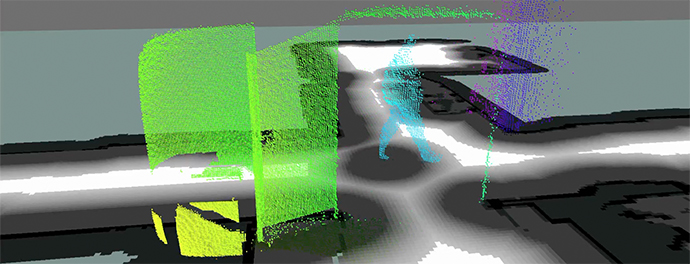Transport of empty hospital beds with mobile robots
August 2019
They can talk together and solve complex tasks, you can do zoned surveillance so they are safe to drive, and in fact they are also cheap to use. Mobile robots have many advantages when working together.
Over the past three years, the Danish Technological Institute (DTI) has investigated the framework for secure communication between mobile robots in the European project SafeCOP ‒ Safe Cooperating Cyber-Physical Systems (CO-CPS) Using Wireless Communication.
In SafeCOP, 28 partners across five countries have investigated far-reaching projects including motorised boats working together to measure and investigate Trondheim Fjord, and mobile robots working together to move hospital beds at Odense University Hospital (OUH).
DTI together with Technicon and the Technical University of Denmark worked on a specific case at OUH, investigating the movement of hospital beds using two mobile robots that communicate together about the task.
The robots had to autonomously move empty hospital beds from A to B ‒ between the Joint Emergency Reception and a central laundry.
Mobile robots in a public and changing environment
‒ In this project we have investigated a number of parameters such as location, navigation, specialized mobile platforms and new management technologies, says Lars Dalgaard, Team Manager at DTI.
‒ Safety and security aspects and situations have been the driving force for the project, he adds.

External camera data extends the field of view of mobile robots and improves navigation
Carsten Holmer, head of the Cleaning and Hospital Service at OUH, says that the project has proved to have great potential.
‒ Robot-assisted transport of material has great potential in hospitals of the future. At the same time, the experience of introducing robots in patient-related areas has shown us that the task can present some challenges, he says.
‒ Technology is evolving at a rapid pace, and it has been exciting to see how DTI has approached the task. We asked them to get robots to move a bed to the washing facilities in a safe way, taking into account the human activity in the surroundings. We have now come much closer to solutions that will be able to run in patient-related areas at New OUH, adds Carsten Holmer.

The robots use a map and measurements from laser scanners to navigate the surroundings. Wireless cameras monitor critical areas such as doorways.
Flexible robot system
The expectation for the flexible, collaborative robot system is that in the future it will also be able to be used on the production floors of manufacturing companies to run from A to B.
‒ The technology is scalable and solutions can be implemented in many industries. We are interested in also finding applications in manufacturing companies, concludes Lars Dalgaard.
In the video at the top of the article you can get a feel for the capabilities of these mobile robot teams ‒ and some of the technologies behind them ‒ when they work together to transport an empty hospital bed from an elevator area to the laundry room.